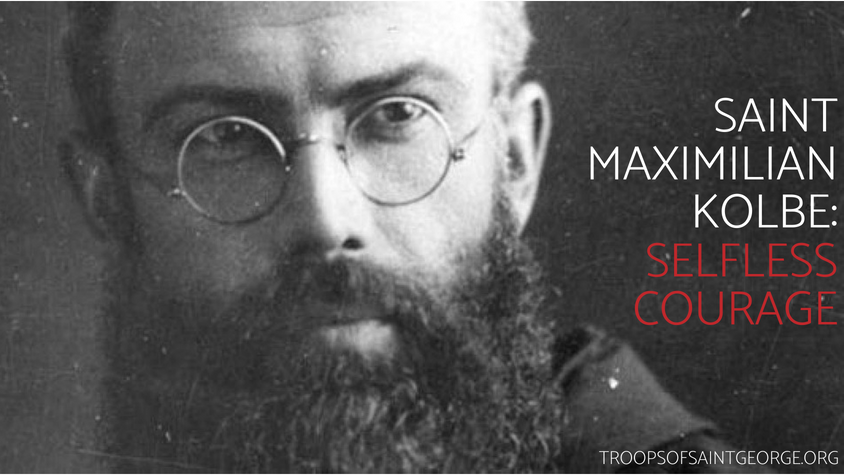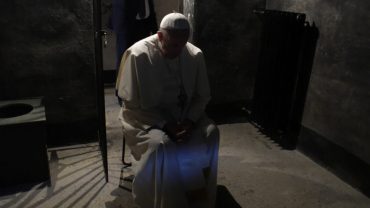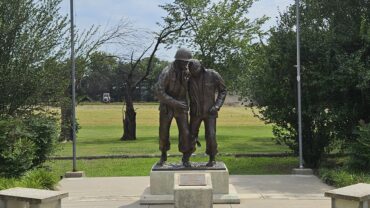

(AUGUST 21, 2018) — I have a short list of what I call “Male Power Saints.” These are the manly men who showed absolute fearlessness in the face of great evil and didn’t bat an eye at death when it stared them in the face. Amazingly, I have a connection to all three.
Saint Pio of Pietrelcina—better known as Padre Pio—was physically assaulted by the devil in his room numerous times. Padre Pio had many gifts—bilocation, the ability to read souls, and he had visits from Jesus and Mary. In 1998, I visited the monastery where he lived, and I saw his cell (room) in San Giovanni Rotondo, Italy. I’ll write more about it next month.
During the Second World War, a young Karol Wojtyła—the future Pope St. John Paul II—studied for the priesthood in an underground (secret) seminary in Warsaw during the Nazi occupation. Had he been discovered, he would have been arrested and likely sent to a concentration camp. I met John Paul five times and will share more about that in a future blog post.
Finally, the third Male Power Saint—Maximilian Kolbe. When he was a boy in Poland, Kolbe had a vision of Our Lady, her arms extended toward him, holding two crowns—one white (purity/priesthood) and the other red (martyrdom). She asked which one he wanted. Both, he replied.
Kolbe went on to join the Franciscans and was ordained to the priesthood in 1918 at the tender age of 24. He formed an association called the Knights of the Immaculata dedicated to spreading devotion to Our Lady using modern media technology. He published a daily newspaper, a monthly magazine with more than a million readers, and a radio station. He also helped establish a religious house, which grew to 800 friars—the largest in the world at that time.
During the 1930s, Kolbe visited Nagasaki, Japan, and established a Japanese version of his magazine, Knight of the Immaculate. He also founded a monastery in Nagasaki on what locals called the “inauspicious” side of the mountain. When the atomic bomb dropped on Nagasaki, the monastery miraculously survived because the other side of the mountain took the brunt of the blast.
During the dark days of World War II, the Nazis arrested Maximilian in a purge of Poland’s clergy and intellectuals. In 1941, he was sent to the death camp in Auschwitz, Poland. One of the country’s best-known evangelists was stripped of all vestiges of his former life and was relegated to manual labor in a striped prisoner’s uniform.
Because he continued his priestly ministry inside the camp, the guards beat Kolbe fiercely. When 10 prisoners disappeared from the camp in July 1941, the deputy camp commander picked 10 men to be starved to death in an underground bunker to deter further escape attempts. Kolbe stepped forward to take Franciszek Gajowniczek’s (one of the selected men) place when he cried out, “My wife! My children!”
During his time in the starvation bunker, Kolbe led prisoners in singing hymns and prayers to Our Lady. After two weeks with no food or water, only Kolbe remained alive. The Nazis injected him with carbolic acid, ending his life on Aug. 14—which is now his feast day.
The simple truth is that love requires sacrifice—sometimes the ultimate sacrifice. But in order to acquire the grace and courage to die for someone like St. Maximilian Kolbe did, we must develop the habit of making small sacrifices of love for others every day. Please make a commitment to daily prayer—including prayer to Our Lady—and to making at least one conscious sacrifice for someone else every single day.
**
As I mentioned, I had a connection to each of these 20th Century Male Power Saints. I visited Auschwitz in 1998 and 1999—both times stopping for prayer at the death bunker where St. Maximilian’s died. These were powerful moments for me!
And, as an additional footnote, the man that Kolbe died to save—Franciszek Gajowniczek—was in St. Peter’s Square when Pope John Paul II canonized him in 1982! He lived an additional 53 years because of St. Maximilian Kolbe’s selfless courage.
PATRICK NOVECOSKY is a seasoned Catholic speaker, journalist and thought leader who runs NovaMedia and blogs at The Praetorium and for TSG in collaboration with iAmplify.




